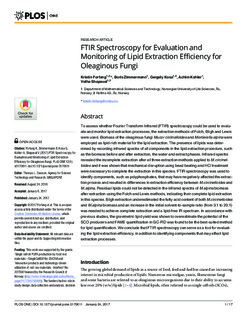| dc.contributor.author | Forfang, Kristin | |
| dc.contributor.author | Zimmermann, Boris | |
| dc.contributor.author | Kòsa, Gergely | |
| dc.contributor.author | Kohler, Achim | |
| dc.contributor.author | Shapaval, Volha | |
| dc.date.accessioned | 2017-10-13T13:04:37Z | |
| dc.date.available | 2017-10-13T13:04:37Z | |
| dc.date.created | 2017-01-30T08:59:47Z | |
| dc.date.issued | 2017 | |
| dc.identifier.citation | PLoS ONE. 2017, 12:e0170611 (1), 1-17. | nb_NO |
| dc.identifier.issn | 1932-6203 | |
| dc.identifier.uri | http://hdl.handle.net/11250/2460097 | |
| dc.description.abstract | To assess whether Fourier Transform Infrared (FTIR) spectroscopy could be used to evaluate and monitor lipid extraction processes, the extraction methods of Folch, Bligh and Lewis were used. Biomass of the oleaginous fungi Mucor circinelloides and Mortierella alpina were employed as lipid-rich material for the lipid extraction. The presence of lipids was determined by recording infrared spectra of all components in the lipid extraction procedure, such as the biomass before and after extraction, the water and extract phases. Infrared spectra revealed the incomplete extraction after all three extraction methods applied to M.circinelloides and it was shown that mechanical disruption using bead beating and HCl treatment were necessary to complete the extraction in this species. FTIR spectroscopy was used to identify components, such as polyphosphates, that may have negatively affected the extraction process and resulted in differences in extraction efficiency between M.circinelloides and M.alpina. Residual lipids could not be detected in the infrared spectra of M.alpina biomass after extraction using the Folch and Lewis methods, indicating their complete lipid extraction in this species. Bligh extraction underestimated the fatty acid content of both M.circinelloides and M.alpina biomass and an increase in the initial solvent-to-sample ratio (from 3:1 to 20:1) was needed to achieve complete extraction and a lipid-free IR spectrum. In accordance with previous studies, the gravimetric lipid yield was shown to overestimate the potential of the SCO producers and FAME quantification in GC-FID was found to be the best-suited method for lipid quantification. We conclude that FTIR spectroscopy can serve as a tool for evaluating the lipid extraction efficiency, in addition to identifying components that may affect lipid extraction processes. | nb_NO |
| dc.language.iso | eng | nb_NO |
| dc.rights | Attribution-NonCommercial-NoDerivatives 4.0 Internasjonal | * |
| dc.rights.uri | http://creativecommons.org/licenses/by-nc-nd/4.0/deed.no | * |
| dc.title | FTIR spectroscopy for evaluation and monitoring of lipid extraction efficiency for oleaginous fungi | nb_NO |
| dc.type | Journal article | nb_NO |
| dc.type | Peer reviewed | nb_NO |
| dc.description.version | publishedVersion | nb_NO |
| dc.source.pagenumber | 1-17 | nb_NO |
| dc.source.volume | 12:e0170611 | nb_NO |
| dc.source.journal | PLoS ONE | nb_NO |
| dc.source.issue | 1 | nb_NO |
| dc.identifier.doi | 10.1371/journal.pone.0170611 | |
| dc.identifier.cristin | 1440580 | |
| dc.relation.project | Nofima AS: 201702 | nb_NO |
| dc.relation.project | Norges forskningsråd: 201708 | nb_NO |
| dc.relation.project | Norges forskningsråd: 234258 | nb_NO |
| dc.relation.project | Norges forskningsråd: 227356 | nb_NO |
| cristin.unitcode | 192,15,0,0 | |
| cristin.unitname | Realfag og teknologi | |
| cristin.ispublished | true | |
| cristin.fulltext | original | |
| cristin.qualitycode | 1 | |

